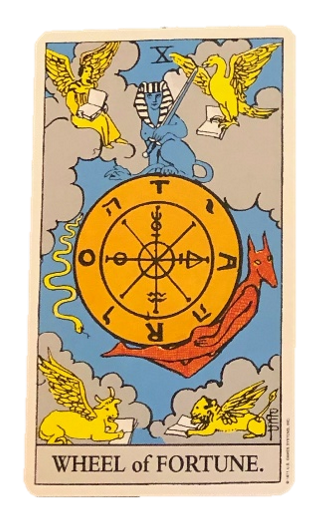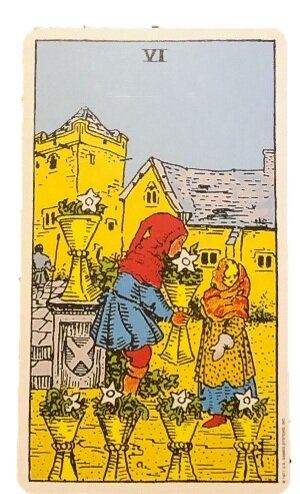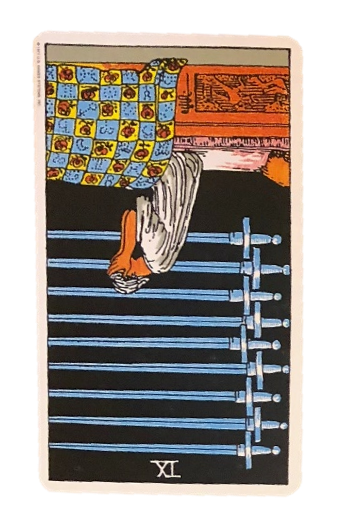Pulling Cards for the Queen of Swords

A deep dive into the themes present in Grenier’s fanciful Fringe production—through a Tarot reading, no less.
In a world where chaos seems to be a constant, some place their faith in the cosmos for guidance and reassurance. For Kingston playwright and Modern Fuel Executive Director Anne-Sophie Grenier, this fascination poses questions and provides structure for her new play Queen of Swords, a totally Tarot production which is part of the 2021 Storefront Fringe Festival and supported by the Kick and Push Festival.
Taking festive inspiration from Charles Dickens’ A Christmas Carol (because why save all the holiday spirit for December?), the piece follows a headstrong Maria who, like the estranged Ebenezer, finds herself alone on Christmas Eve. What begins as a wine-fuelled tirade peppered with cheeky remarks from a voice-command AI system gradually takes a turn for the mystical as spirits begin to appear in accordance with an anguished Tarot card reading.
Just as Scrooge’s spectres compel him to reconsider his insensitivities, Maria’s ghosts ask her to revisit a murky past year of isolation (we’re not getting away from the pandemic that easily). Much like a typical Tarot card reading, it’s up to Maria to determine the nature of each character and to uncover what their appearance might be asking of her.
As the play finds its narrative structure in Maria’s three-card reading, I find it suitable, being a Tarot reader myself, to provide a three-card response.
1. Wheel of Fortune

As the wheel of life spins on and on, so too spins the wheel of karma. Finding the Wheel of Fortune in a reading could signify a sense of fluctuation, the process of time rolling on, or receiving back the energy that you have been putting out into the universe.
With the piece situated in December 2021, Queen of Swords draws on experiences of isolation that audience members will most likely find relatable. Watching Maria come to grips with loss, heartache, and a changing sense of self, I pondered the ways in which my own identity and relationships with others have changed since March 2020. How does one come to terms with the things that have been lost? What opportunities have appeared amidst the madness that I’m taking for granted? When am I not truly considering the experiences of others?
Just as the wheel on the card turns between a strong and knowledgeable Sphinx to the obsessive, snake-like Typhon, so too do the tides shift from good to bad. Through acknowledging Maria’s struggles and triumphs during the pandemic, hopefully the audience will be able to consider and appreciate how far they have come as well.
2. Six of Cups

In this card, there are six cups filled with white flowers. A child smells one as they gleefully gift the cup in what appears to be a quaint backyard garden. This card can be used to symbolize feelings of innocence and nostalgia, recalling a simpler way of thinking.
In terms of the performance, I call upon this card to signify the blissful and long-awaited act of gathering. For many audience members (myself included), this year’s Fringe will be the first live performance seen in a theatre space for many moons, and the sense of presence is electrifying. The cast does a great job of facilitating this energy, with each character adding new tensions and provocations upon arrival.
I do wonder, however, if too much nostalgia can be problematic. Before her apparitions appear, the piece uses the act of Maria berating a colleague for not preparing a good enough land acknowledgement, as a land acknowledgement.
Although the moment is purely satirical, playing at diversity quotas and shallow acts of reconciliation, I wonder if this framing is using acknowledging the land as a punchline. Could there be a way for Maria to reconsider this moment later in the play as an indication of the importance of establishing a relationship with the land and its past and present inhabitants?
While the performance offered a jubilant space of gathering that felt nostalgic, this moment made me wonder what customs should be challenged in the present.
3. Nine of Swords (Reversed)

For the third and final card, a figure sits uneasily in bed. Nine swords hang ominously behind them. Seeing the Nine of Swords in a reading could indicate a troubled time, prolonged suffering, or cruelty. In its reversed position, the card suggests freedom from these restraints.
In terms of character suffering, I would argue that Maria goes further than Ebenezer Scrooge when it comes to a dwindling mental state. While (spoiler alert) she does achieve an ultimate transformation, it is not without hitting some deep lows along the way, including expressing depressive mannerisms, potential alcoholism, and multiple contemplations of suicide.
While viewing this trajectory, my mind split into two different directions. On one hand, I felt validated in seeing the mental distress that I certainly have felt during the pandemic (though maybe not so intensely) reflected; but on the other hand I questioned how a character repeatedly considering taking their own life due to pandemic complications could be triggering for some audience members.
Though the piece is self-rated ‘M for Mature’ and audiences should implicitly expect some emotional turmoil, I hope that the ‘cutting edge’ nature of Queen of Swords doesn’t cut someone too deep along the way. That being said, it is with this sword that Maria is able to free herself from her woes and emerge triumphant.
Ultimately, I found Queen of Swords to be a very enjoyable trip back to the theatre. Themes of isolation paired with the act of physically gathering to consider them created a dynamic experience, but with a maturity warning that should be heeded.
Queen of Swords is on at the Storefront Fringe until Sunday, August 15th, 2021. Check out the Storefront Fringe for tickets and more information.
